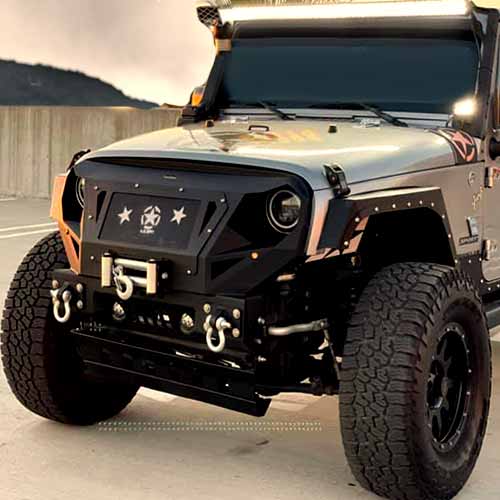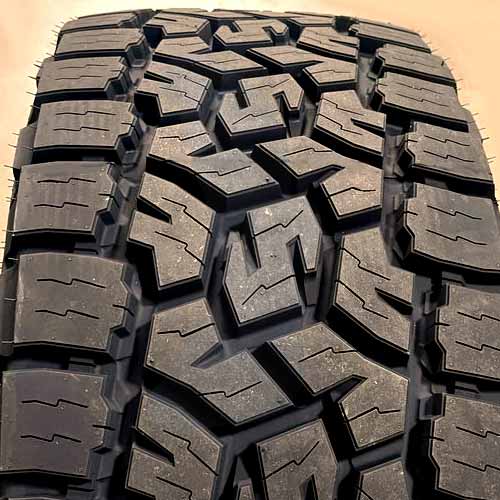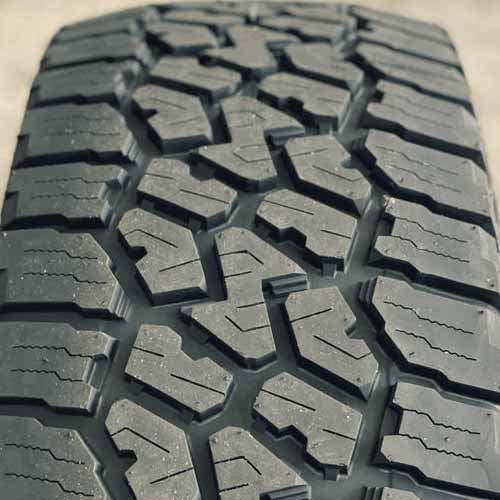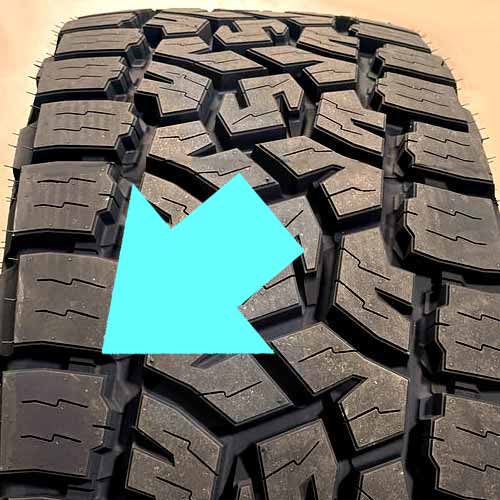Looking at the Toyo Open Country AT3 and the Falken Wildpeak AT3w (which, by the way, has been updated to AT4w) shows that even though they’re designed similarly, they offer very different experiences on both highways and rugged terrains. Their treads are built for reliable traction, giving a decent footprint, and their specialized voids and siping patterns lead to better slip resistance. However, there are a few key features that set one apart from the other. Let’s dive into those differences.

Here’s The Deal: The Toyo Open Country AT3 really shines with its excellent dry grip and stable lateral traction. It offers a solid footprint, providing more control and responsiveness when you’re steering, plus it’s quieter too, which is a great perk. On the other hand, the Falken Wildpeak AT3w holds its own on dry ground but it really takes the lead on wet surfaces, thanks to its smart multi-channel siping pattern that enhances grip. Other than that, both boys provide good enough off-road traction, but the weaker sidewalls on the Toyo do make me a bit nervous.
Things you can’t miss about these tires:
- Thicker lugs of the Falken Wildpeak AT3w provides better traction with lowered psi pressure levels.
- Toyo Open Country AT3 provides a very stable on road experience, but off road, the tire could use some extra biters especially on shoulders.
- Both are 3 peak mountain snowflake rated where there is only marginal difference (covered in the winter section below)
- Both tires offer same UTGQ ratings, but tread depth is seen more on Wildpeak.
Side Note: You can now compare the Wildpeak AT3w with its successor, the Falken AT4W.
Durability
All Terrain tires need to be tough, otherwise they won’t be able to handle rugged off road terrains, where you encounter sharp logs and rocks everywhere.
The Falken Wildpeak AT3w (review) does things right here. The tire has a thicker tread and has a stronger inner construction having 2 layers of polyester casing (the skeleton of the tire) which is then topped with high tensile steel made belts (again 2 layers), and then these belts are topped with 2 more layers of another durable polyester.
But steel belts and the end layered polyester don’t cover the sidewalls, so for sidewalls, the tire has 2 extra layers of another polyester compound which runs around the tire’s rim protector.
Now compare to this: Toyo Open Country AT3 (review), although has same 2 ply inner polyester casing and 2 steel belts, but on top of that, there is only 1 layer of nylon, and nothing else covers the sidewalls.
So you end up with very weak sides on Toyo AT3, just 2 ply compared to Falken Wildpeak’s 4 ply construction.
The single layer of nylon over steel belts also makes the central part of the tire less sturdier, and with less tread depth, the rubber layers on top also aren’t thick enough where Falken Wildpeak AT3w provides you with deepest tread in the category.
It’s one of the reason, why I added this tire to the top of my Best All-Terrain tires list.
Tread Appearance

On Toyo Open Country AT3, the tire offers very noticeable S shaped ribs where the surrounding ones look like the letter F.
Actually notches give them this shape.
The shoulder blocks are less aggressive and don’t have notches and instead they have connectors between them. But they are still staggered and have mud scoops on the edges.
Also all blocks have similar siping and they are not a lot in number, and this amazes me on how with lesser siping the tire qualifies for severe winter rating.
It also has no stone ejectors anywhere but does make wide enough outer longitudinal channels for dirt and water to evacuate.
On the other side, the dual siping on Falken Wildpeak AT3w makes sense as to why this tire is so good on wet roads.

The the shoulder blocks besides having a zigzag shape to the sipes also interlock in the middle. This give it’s shoulder blocks great flexibility.
The central blocks have slightly less number of sipes but they are also full depth and interlock.
These blocks also have sharp biters in the form of ramps or you can say stair shaped, which are also seen on shoulder blocks.
Other than this, the shoulder blocks also have connector in between which are not as prominent.
And in a similar way, this tire also does not make any stone ejectors and is prone to getting stones stuck in grooves just like the Toyo Open Country AT3.
Tread Longevity
Both tires are constructed with computer optimized tread design which promote even wear, due to reduced rolling friction. Their rubber are equipped with long chained carbon (in the formation of polymer), this chemical composition makes their tread chip and cut resistance.
But when it comes to wear, durability is also a key factor and here Falken Wildpeak AT3w has an advantage as I talked about in the above category.
The tire also offers tread depth up to 19/32″ and this further increases the time it would take to wear down this tire.
Toyo Open Country AT3 on the other hand, tackles with wear by making its tread stiffer and placing ridges between blocks, seen above.
So it’s more prone to wear that way. Overall, both tires wear almost the same, but with tires having less tread depth would wear faster (as there are sizes in Wildpeak with even 13/32″ tread depth).
For Your Info: The perfect tire in terms of wear, (in all terrain category) is the General Grabber ATx. You can review this tire here: https://tiredriver.com/general-grabber-atx-review/
Noise Reduction
The ridges between the shoulder blocks that I just talked about above, provide blockage for the noise to pass through. Most of the noise is generated from the shoulders, as that’s the point where most of the air either goes in or out.

With ridges, the Toyo Open Country AT3, restricts the path for air to move, and this dampens the noise.
Cooper uses this technology very often and names it whiper groove tech.
This technology is also seen in Falken Wildpeak AT3w but the ridges on this tire are smaller in comparison.
Overall, although there isn’t going to be too much of a difference, the noise levels on Toyo would be slightly better.
Comfort Performance
Falken Wildpeak AT3w breaks the norm, that AT tires can’t provide a decent highway comfort. The tire is very smooth on both dry and wet roads.
It’s smooth ride is credited to it’s silica rich compound which offers softer, yet elastic rubber. That’s why the tire with a more spongy tread is able to absorb the impacts nicely.
Tread depth also has a direct relation to the comfort of the ride. The more the tread depth, the more comfortable the ride will be.
A higher tread depth would mean that there is more shock absorbance
Due to this, there will be more cushion between the tire and the road ensuring a more comfortable ride. And as the Falken Wildpeak AT3w provides the deepest tread in the category, it has more area to soak up the bumps.
The Toyo Open Country AT3, lacks in both rubber composition and tread depth in this case. The harder rubber of the tire makes ride slightly more stiffer, while the less tread depth affects that further.
On-Road Performance
Highway performance is something, which is not expected too much out of all terrain tires, yet these two tires changed that and now it has become a myth.
The Falken Wildpeak AT3w specifies good handling due to large shoulders. Its elongated lugs specifying a close arrangement make the shoulders bulkier.
Toyo Open Country AT3 offers superior dry grip with it’s more stable rib placements on tread.
Wet Traction
Falken Wildpeak AT3w is the king of wet roads in all terrain tires. Sure you will find better tires out there, but let me ask you this… are they also as capable of facing rugged terrains like Falken Wildpeak?
Usually the more the aggressive the tire gets, the more it loses its wet capabilities.
But even with the aggressive tread of Falken Wildpeak AT3w, the tire does not compromise at all and shows superior wet braking distances and handling times.
For Your Info: Comparing BF Goodrich KO2 , the Toyo Open Country AT3 performed better on wet roads.
Dry Traction
When it comes to Toyo Open Country AT3, the tire gives out a very alert feedback to any minor changes on the steering wheel.
The tire provides a very stable composition having a stiffer compound in comparison. All of the ribs also have reinforced foundations underneath, so they further enhance the ribs stability during cornering and braking.
The shoulder blocks have a larger share in tire’s handling. And here the ridges between the blocks keep the block’s position intact and enhances handling.
Also because there no notches in this area and the tire has fewer sipes, both promote more rubber to road contact which increases the friction with the pavement.
The Falken Wildpeak AT3w on the other hand, also provides very similar dry traction, The tire offers softer compound which sticks on the surface evenly, and the supporting ridges on these ribs don’t allows these soft blocks to move too much.
So, this tire brings in a prefect combination of softness and stability.
The shoulder blocks are longer, with slightly more lateral spacing, but each is still connected by the other with a small connector which is barely visible, see if you can find it in them image above. This enhances the tire’s ability to corner in a better way.
Overall dry handling is more stable on Toyo, as on Falken Wildpeak AT3w, the response seems slightly slower.
Fuel Efficiency
Fuel economy and rolling resistance go hand in hand. The more rolling resistance, the more fuel would be consumed.
Many factors contribute to rolling resistance. To name a few, there is weight, rubber composition, tread width, grip, biting edges and so on…
Out of both of these tires the Toyo Open Country provides slightly better fuel economy. It’s stiffer compound and less overall average weight all contributes to the tire’s lower rolling resistance.
The stiffer compound is better as less compression occurs with the ground, let’s not go too much in to science, just think of it as why more pressure makes fuel economy better? Well, because that makes the tire more stiff and Toyo’s boy is already stiffer.
The Falken Wildpeak AT3w has a softer rubber and has more average weight in almost all sizes as it provides more layers underneath for durability, so more fuel is consumed with this tire.
You are going to notice almost 1 to 2 mpg different when switching E rated tires.
Total sizes
The Falken Wildpeak AT3w provides you with 76 total sizes, ranging from 15 to 22 rim sizes.
Most of the sizes come in 17 inches, and only one comes in 22 with XL load rating.
The tread depth varies from 12/32″ (in only 22″) and goes up to 19/32″ and the weight range is from 35 to 79.4 pounds.
On Toyo Open Country AT3, offers more sizes, ranging from 15 to 22 inches. Tread depth ranges from 12.7 to 17/32 (on only one size).
And weight range goes form 28 to 72 lbs.
Learn these rating terms:
What is speed rating?
What is load rating?
How to read tire size?
Snow Performance
Toyo Open Country AT3 provides a stiffer composition which with freezing temperatures loses a little snow traction, but the tire is still great with it’s multiple biters which trap the snow efficiently.
Its slightly rounder, and has tread width as well and both of these are very effective for snow traction.
But the tire’s not impressive on the siping department and that’s where the Falken Wildpeak AT3w comes in. This tire offers dual siping which interlock and trap the snow.
Furthermore, the side bitters seen on the blocks provide snow vices aiding traction on snow. And of course, with deeper tread, even thicker snow is not going to be an issue for this puppy.
For Your Info: Comparing Falken Wildpeak AT3w, General Grabber ATX gave superior winter traction.
Off Road Performance
Off road things thing change very quickly. And sure, both tires offer decent biters, but I am always impressed with neat features that come with Falken Wildpeak AT3w.
With such wild design, this tire is a hybird in my books (hybrid tires are more rugged then All Terrains). It offers very gripping compound and it’s saw tooth edges and shoulder lugs are more than enough for traction, especially on rocks.
Muddy Terrain Traction
Usually AT tires are notorious for getting stuck in mud. Mud is thick and it needs room to move or be moved. For that a tire needs to be powerful, heavier and should have wide enough room to trail out the mud.
The Falken Wildpeak AT3w is heavier, it’s notches and chamfered edges break down the mud efficiently, and the crushed mud passes through it’s lateral and outer longitudinal rings more easily in comparison.
Each of the tire’s shoulder block is serrated on itself, and this scoops the mud out while the sharp ramps outside act as powerful diggers.
Even in slightly deeper mud, the U shaped shoulder lugs on the sidewall act as mud scoops and provide this tire better lateral stability.
The Toyo Open Country AT3 with a lighter weight does not put too much pressure on the mud, but the mud does get crushed by it’s multiple biters, however, with less tread depth and width, the mud is not cleaned off quickly.
And although its shoulder blocks are staggered and they make decent mud scoops, the thinner sidewall lugs does not help this tire too much, when compared.
Sand Performance
Sand is slightly different from the mud. It’s soft on top and becomes harder underneath. So here forward momentum is very important.
Both tires have a few features that aid them in this terrain.
The Falken Wildpeak AT3w is softer, so with less air pressure the tire can make good contact with the sand. But with more extra polyester ply on the sidewalls combined with 2 layers of polymaide, the tire still makes slightly stiffer sidewalls.
The weight of the tire also puts more pressure on the sand and the sharp saw tooth edges on the sides make these tire better digger when compared.
In other words, as this tire is a better digger, it’s going to be little harder to carry on the forward momentum, especially on slopes.
The Toyo Open Country AT3 on the other hand with lighter weight and softer sidewalls with scoops provide better traction on sand.
Rocky Terrains Performance
On rocks, durability counts, and this does not look good for Toyo Open Country AT3. Going off road with this tire is not going to give you a care-free confidence as sharp thrones or rocks can easily pierce through it’s 2 ply sides.
Side Note: Comparing Falken Wildpeak AT3w, the BF Goodrich KO2 provides better durability.
Falken Wildpeak AT3w is better here in terms of protection. The tire’s softer compound also sticks better on rocks during climbing. And it’s aggressive lugs aid more during flexing sidewalls when you have to air down the tires to lower PSI.
The tire also offers more biters in comparison, for example, see the tread pattern again in the image above, considering shoulder blocks on both. The Toyo Open Country AT3 does not provide any kind of side steps or ramps or even notches, where the Falken Wildpeak AT3w offers alternating blocks where one has notches and other has ramps.
Also the chamfered edges on the Z shaped blocks as well as more number of sipes, also act as biting edges through the tread.
Which tire offers better value to money?
Price is something that changes, but still the Falken Wildpeak AT3w really impresses here. The Toyo Open Country is also not too bad, but I’m just a real fan of Wildpeak’s wet performance and on road comfort.
For Your Info: In my detailed list of all terrain tires (best ever), I’ve added Kenda Klever AT2 to be the best value for money tire. It’s probably the cheapest you can get with 3pmsf rating.
Take Home Points
Toyo Open Country provides overall better stability on dry roads, and on wet it provides ample hydroplaning resistance.
Off road, the tire lacks in durability and aggressiveness but still provide a satisfactory performance.
The Falken Wildpeak is almost on par in terms of dry performance, with deeper tread, it also offers more resistance to hydroplaning. And with more durability and biters the tire is also superior off road.
As for the snow, both tires deserve the 3PMSF rating symbol they have.